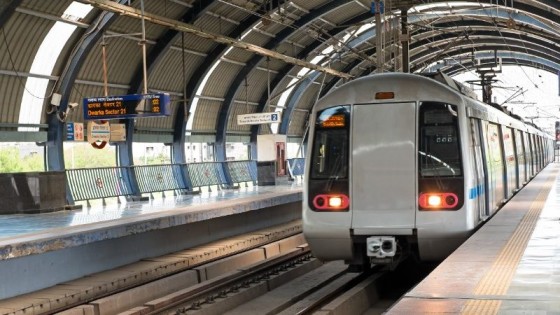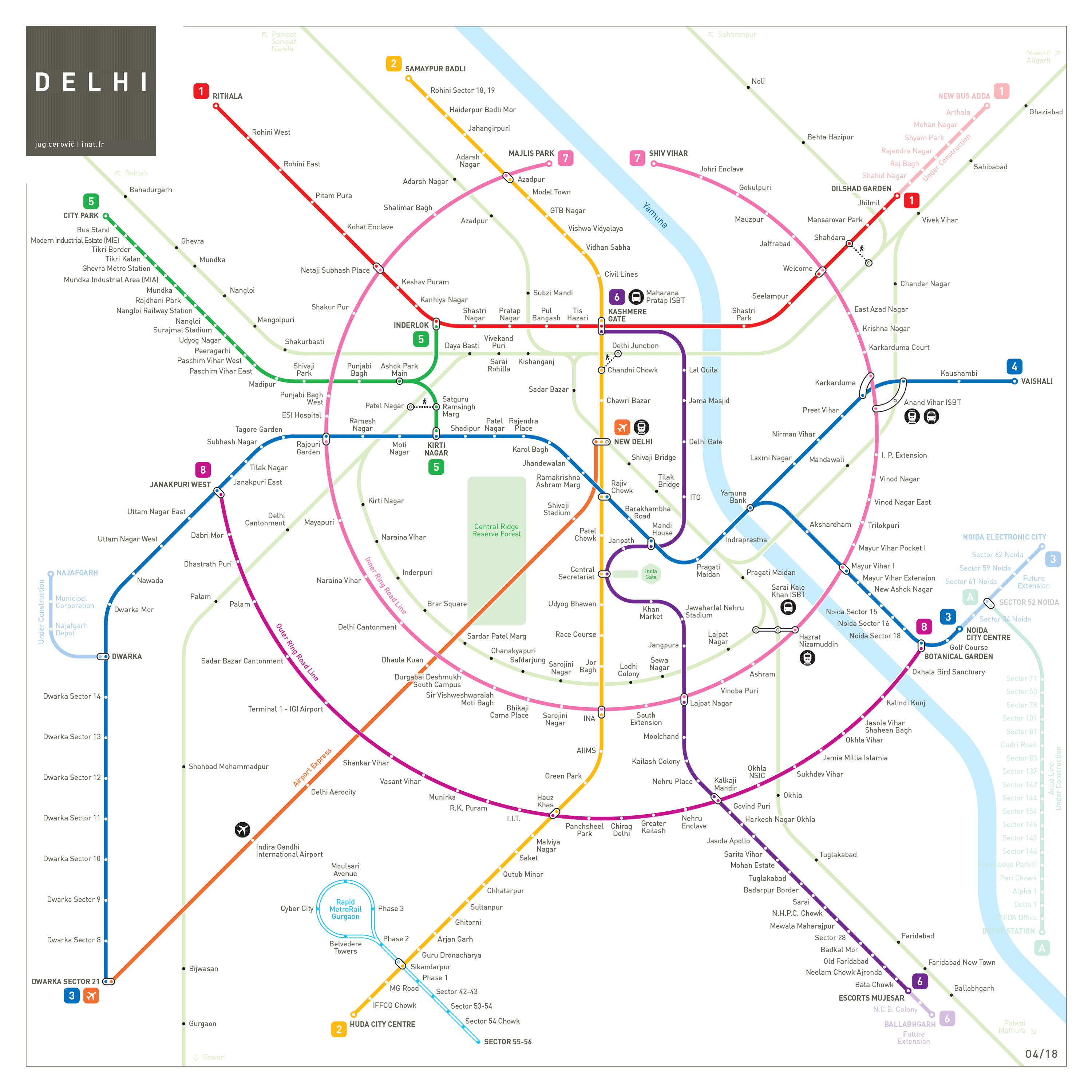India's energetic capital city of Delhi is renowned for its busy streets, varied culture, and lengthy history. The demand for pleasant and effective transit increases as a city expands. For millions of people who commute every day, the Delhi Metro is a lifeline and a marvel of contemporary infrastructure. The goal of this guide is to help you negotiate the Delhi Metro's complexities so that your trip is smooth and enjoyable.
 Understanding the Delhi Metro Network
Understanding the Delhi Metro Network
More than merely a transportation system, the Delhi Metro is a complex network that links different areas of the city. The system is split into multiple color-coded lines, each of which serves a distinct set of locations and landmarks. The Airport Express Line, Red Line, Blue Line, and Yellow Line are a few of the important lines. For the purpose of planning your trip, a thorough metro map is provided at every station and online.
Different Lines of Delhi MetroThe Delhi Metro, an integral part of the city's public transportation network, consists of several lines, each distinguished by unique color coding. These lines interconnect different parts of Delhi and its surrounding areas, making travel convenient and efficient. Here's an overview of the different lines:

- Red Line (Line 1): Route is from Rithala to Shaheed Sthal (New Bus Adda). As the first line of the Delhi Metro, it connects North Delhi with Ghaziabad in Uttar Pradesh. It passes through densely populated areas and serves as a crucial link for daily commuters.
- Yellow Line (Line 2): Route is from Samaypur Badli to HUDA City Centre. This line is significant as it passes through Delhi’s key business districts and historic areas, including Chandni Chowk and Chawri Bazar. It also connects to Gurugram in Haryana.
- Blue Line (Line 3/4): Route is from Noida Electronic City to Dwarka Sector 21 and Vaishali to Yamuna Bank. One of the longest and busiest lines, it connects Delhi with Noida in Uttar Pradesh and Dwarka in West Delhi. This line has a branch from Yamuna Bank to Vaishali, extending its reach in the NCR region.
- Green Line (Line 5): Route is from Inderlok/Kirti Nagar to Brigadier Hoshiyar Singh. It primarily serves the West Delhi region and acts as an important feeder line for the dense residential areas.
- Violet Line (Line 6): Route is from Kashmere Gate to Raja Nahar Singh (Ballabhgarh). This line connects Central Delhi to the Faridabad district of Haryana. It is known for its connectivity to prominent historical sites, including the Red Fort and Humayun’s Tomb.
- Orange Line (Airport Express): Route is from New Delhi Railway Station to Dwarka Sector 21. This line is specially designed for faster connectivity to the Indira Gandhi International Airport. It’s known for its premium features, including high-speed trains and additional facilities for travelers.
- Pink Line (Line 7): Route is from Majlis Park to Shiv Vihar. The Pink Line is known for its ‘Ring’ structure, almost encircling the city, and providing interconnectivity between several radial lines.
- Magenta Line (Line 8): Route is from Janakpuri West to Botanical Garden. This line provides direct connectivity between West Delhi and Noida, and it also connects to the Domestic Terminal of the Delhi Airport.
- Grey Line (Line 9): Route is from Dwarka to Najafgarh. Serving as an extension to the Blue Line, this shorter line connects the outer regions of Dwarka with Najafgarh.
- Aqua Line: Route is from Noida Sector 51 to Depot Station. Operated by Noida Metro Rail Corporation, it connects various sectors of Noida and is integrated with the Delhi Metro network.
| Metro Line | Length (KM) | Starting Point – End Point |
|---|---|---|
| Red | 34.6 | Shaheed Sthal – Rithala |
| Yellow | 49.3 | Samaypur Badli – HUDA City Centre |
| Blue | 56.6 | Dwarka Sector 21Noida – Electronic City |
| Green | 26.3 | Inderlok – Brigadier Hoshiyar Singh |
| Violet | 46.6 | Kashmere Gate – Raja Nahar Singh (Faridabad) |
| Orange | 20 | Kashmere Gate – Raja ECC Centre – Dwarka Sector 25– New Delhi Railway Stationtd> |
| Pink | 57.5 | Majlis Park – Shiv Vihar |
| Magneta | 37.4 | Botanical Garden – Janakpuri West |
| Grey | 5.19 | Dwarka – Dhansa Bus Stand |
Each of these lines has been designed to maximize coverage across Delhi and its surrounding regions, reducing travel time and enhancing connectivity. With constant expansions and upgrades, the Delhi Metro continues to evolve, further cementing its role as a backbone of urban transportation in the National Capital Region of India. Ticketing and Fares
Tokens and smart cards are only two of the many ways to purchase tickets on the Delhi Metro. Tokens are good for one-time trips, but smart cards are a more practical choice for frequent travelers because they come with extra features like hassle-free travel and fare discounts. The DMRC's official website or the stations both allow you to check the fare for your trip, which is determined by the distance traveled. Timings and Frequency
Operating hours for the Delhi Metro typically range from early morning to around midnight, with trains running at a frequency of every few minutes. The exact timings and frequency can vary depending on the line and the day of the week, so it’s advisable to check the latest schedule, especially if you plan to travel early in the morning or late at night. Facilities and Accessibility
A number of amenities are included in the Delhi Metro to guarantee a comfortable ride. This includes amenities for passengers with disabilities, air-conditioned carriages, clean stations, escalators, and elevators. Restrooms, food stands, and ATMs are also available at most stops. Safety and Security
Safety is a top priority in the Delhi Metro. Each station is equipped with security personnel and CCTV surveillance. Additionally, there are dedicated Women’s Coaches in each train, ensuring a safer travel environment for female passengers. Tourist-Friendly Services
The Delhi Metro is a godsend for travelers. It connects prominent landmarks such as the Qutub Minar, the Red Fort, and the Akshardham Temple. There are also 'Tourist Cards' available, which provide unrestricted travel for a limited time and are ideal for visitors wishing to explore the city.
Navigational Tips- Always check the last train’s timing for your return journey.
- Keep an eye on the electronic display boards for train arrival times and destinations.
- Follow the directional signs and maps at the stations to navigate between lines.
- Be mindful of the rush hours, usually in the morning and evening on weekdays.
The Delhi Metro, known for its efficiency and reliability, holds several special facts and achievements that make it stand out not just in India, but also on the global stage:
- Pioneering Rapid Transit in India: Delhi Metro was India's first modern public transportation metro system, revolutionizing urban transit in the country.
- Environmental Recognition: The Delhi Metro was the first railway project in the world to be certified by the United Nations as a Clean Development Mechanism (CDM) project, which enabled it to earn carbon credits for its regenerative braking system.
- Extensive Network: Spanning over 390 kilometers, the Delhi Metro has multiple lines that interconnect to cover a vast area of the National Capital Region. This makes it one of the largest metro systems in the world.
- High Ridership: Prior to the COVID-19 pandemic, the Delhi Metro had a daily ridership of over 2.7 million passengers, showcasing its importance as an integral part of daily life in Delhi.
- Women’s Safety: Dedicated coaches for women, known as 'Women's Coaches', were introduced to ensure safety and comfort, a feature that was later adopted by other metro systems in India.
- Architectural Marvels: Many stations, like the Jawaharlal Nehru Stadium and Mayur Vihar Extension, are noted for their unique and innovative architectural designs.
- Cultural Integration: The metro stations are adorned with artworks, murals, and installations that reflect India’s rich cultural heritage and contemporary art.
- Barrier-Free Access: The entire network is designed to be accessible to people with disabilities, featuring facilities like ramps, lifts, and tactile paths for visually impaired passengers.
- Energy Efficiency: The Delhi Metro is focused on energy conservation. It uses solar power at several of its stations and depots and plans to increase its use of renewable energy sources.
- Technological Innovations: The Delhi Metro incorporates advanced technologies such as regenerative braking systems, modern signalling, and telecommunication networks for efficient operations.
- Academic Research and Training: The Delhi Metro Rail Corporation (DMRC) established the Delhi Metro Rail Academy (DMRA) for training its staff and for research in the field of mass urban transportation.
- International Collaborations: The DMRC has collaborated with international metro systems and institutions for technological and operational advancements.
- Tourist Friendly: The Delhi Metro offers 'Tourist Cards' for unlimited travel, which is particularly convenient for visitors exploring the city.
- Underground Challenges: Constructing the underground sections was a major engineering challenge, especially near historically significant areas where the risk of damage to ancient structures was high.
These facts showcase the Delhi Metro as not just a means of transportation, but as a symbol of urban development, technological progress, and cultural integration in India.